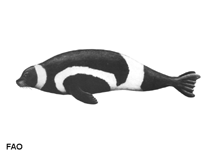Histriophoca fasciata (Zimmermann, 1783)
Ribbon seal| Native range | All suitable habitat | Point map | Year 2050 |

|
| This map was computer-generated and has not yet been reviewed. |
| Histriophoca fasciata AquaMaps Data sources: GBIF OBIS |
Classification / Names Common names | Synonyms | CoL | ITIS | WoRMS
Mammalia | Carnivora | Phocidae
Environment: milieu / climate zone / depth range / distribution range Ecology
Bathydemersal. Temperate; 90°N - 41°N, 138°E - 130°W
Distribution Countries | FAO areas | Ecosystems | Occurrences | Introductions
Northern Pacific and the Arctic. Strays in California. Boreal to polar.
Length at first maturity / Size / Weight / Age
Maturity: Lm ? range ? - ? cm Max length : 180 cm TL male/unsexed; (Ref. 1394); max. published weight: 148.0 kg (Ref. 1394)
Feeds on several species of fish and crustaceans (Ref. 1394). Physiology indicates adaptability to life in the open ocean. In spring and early summer, they prefer the continental shelf slope, hauling out on ice near or over deeper water. Feeds intensively during ice-free and winter months, wherein diet is suggested to be based on distribution and potential prey. Mainly consumes pelagic and nektobenthic prey (Ref. 119413). Feeds on several species of fish and crustaceans (Ref. 1394).
Life cycle and mating behavior Maturity | Reproduction | Spawning | Eggs | Fecundity | Larvae
Main reference
References | Coordinator | Collaborators
Jefferson, T.A., S. Leatherwood and M.A. Webber. 1993. (Ref. 1394)
IUCN Red List Status (Ref. 130435)
Least Concern (LC) ; Date assessed: 09 June 2015
CITES status (Ref. 108899)
Not Evaluated
CMS (Ref. 116361)
Not Evaluated
Threat to humans
Human uses
Fisheries: commercial
FAO - Fisheries: landings, species profile | FishSource | Sea Around Us
Tools
More information
Internet sources
BHL | BOLD Systems | CISTI | DiscoverLife | FAO(Fisheries: species profile; publication : search) | Fishipedia | GenBank (genome, nucleotide) | GloBI | Gomexsi | Google Books | Google Scholar | Google | PubMed | Tree of Life | Wikipedia (Go, Search) | Zoological Record
Estimates based on models
Preferred temperature
(Ref. 115969): -0.4 - 4.9, mean 2.4 (based on 2322 cells).
Resilience
(Ref. 69278):
High, minimum population doubling time less than 15 months (K=0.37-0.57).
Price category
(Ref. 80766):
Unknown.



